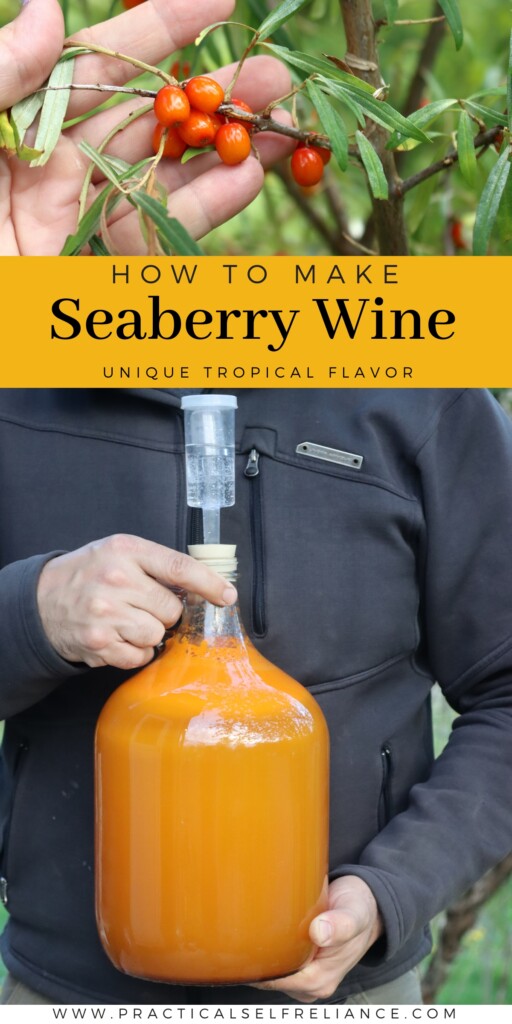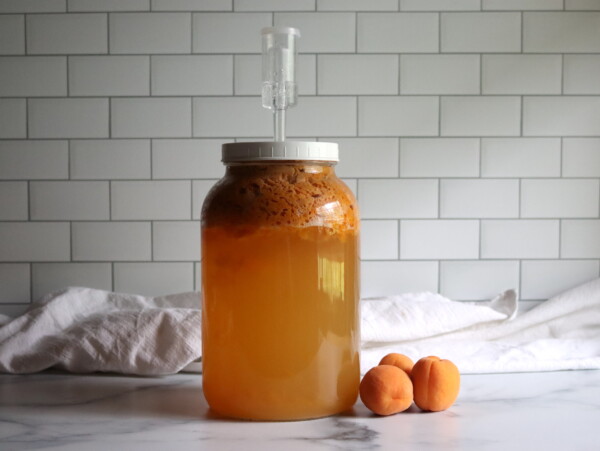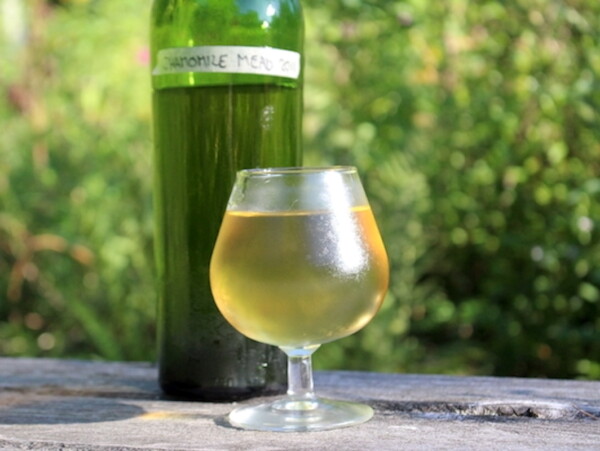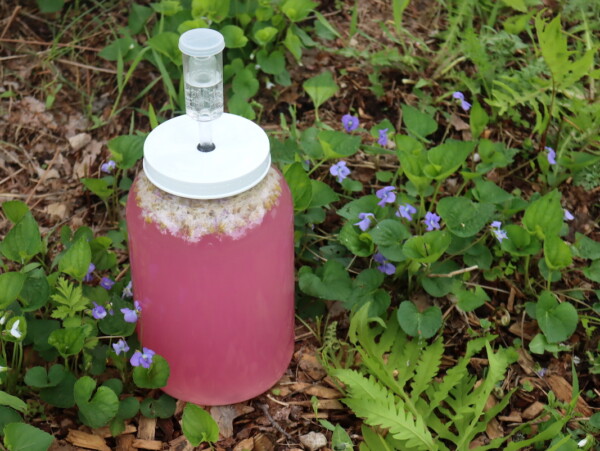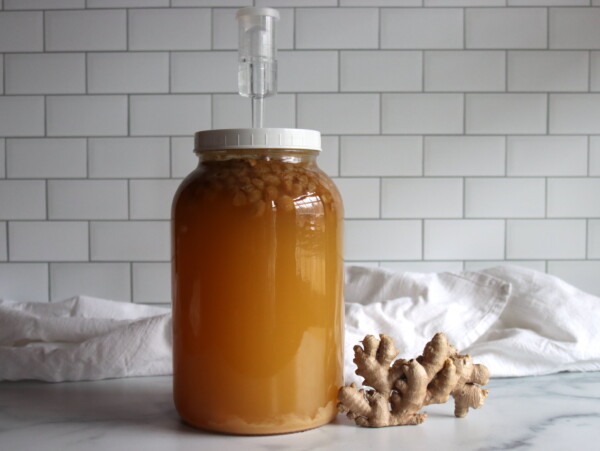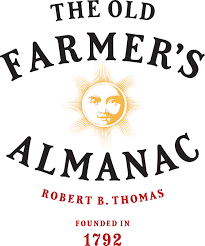Affiliate disclosure: This post may contain affiliate links. Please see our Privacy Policy.
Seaberry wine is a bold, citrusy fruit wine made from sea buckthorn berries—those bright orange fruits packed with vitamin C, antioxidants, and a tart, tropical flavor. While seaberries can be overpowering eaten fresh, they mellow beautifully during fermentation, creating a wine that’s crisp, fruity, and unlike anything else you’ve tasted.
Use honey instead of sugar to turn this recipe into Sea Buckthorn Mead!
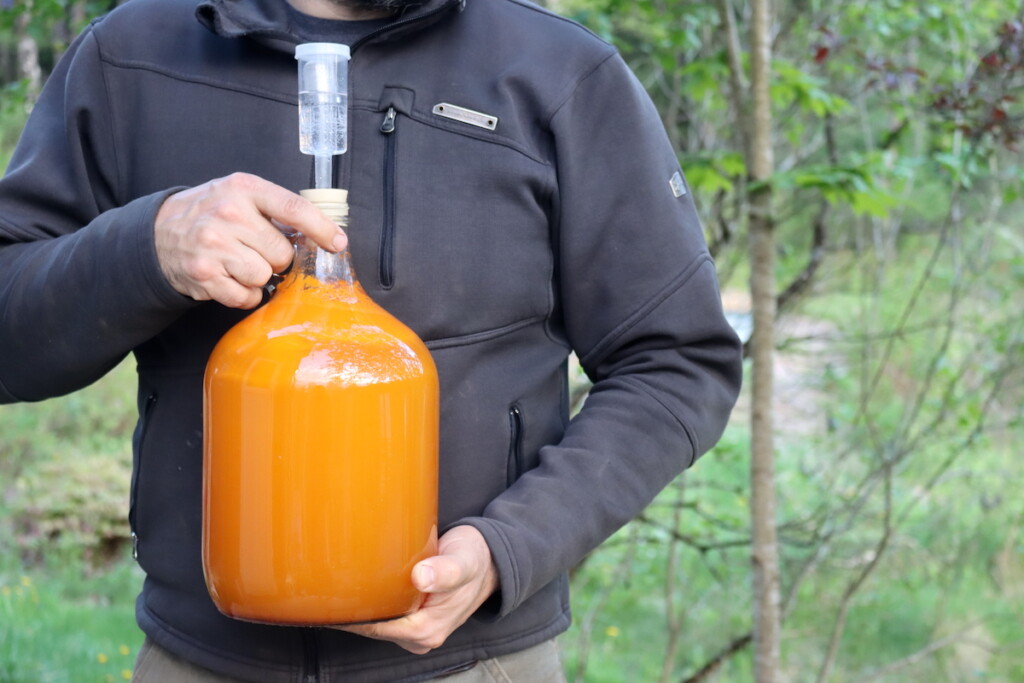
If you’re lucky enough to have a thriving seaberry bush (or access to frozen berries), making wine is a great way to preserve the harvest. Like elderberry or blackcurrant wine, seaberry wine holds its color and acidity well and only gets better with age.
Whether you forage your berries, grow seaberries yourself, or find them at the farmer’s market, this recipe will walk you through turning seaberries into a delicious homemade wine with just a few basic ingredients.
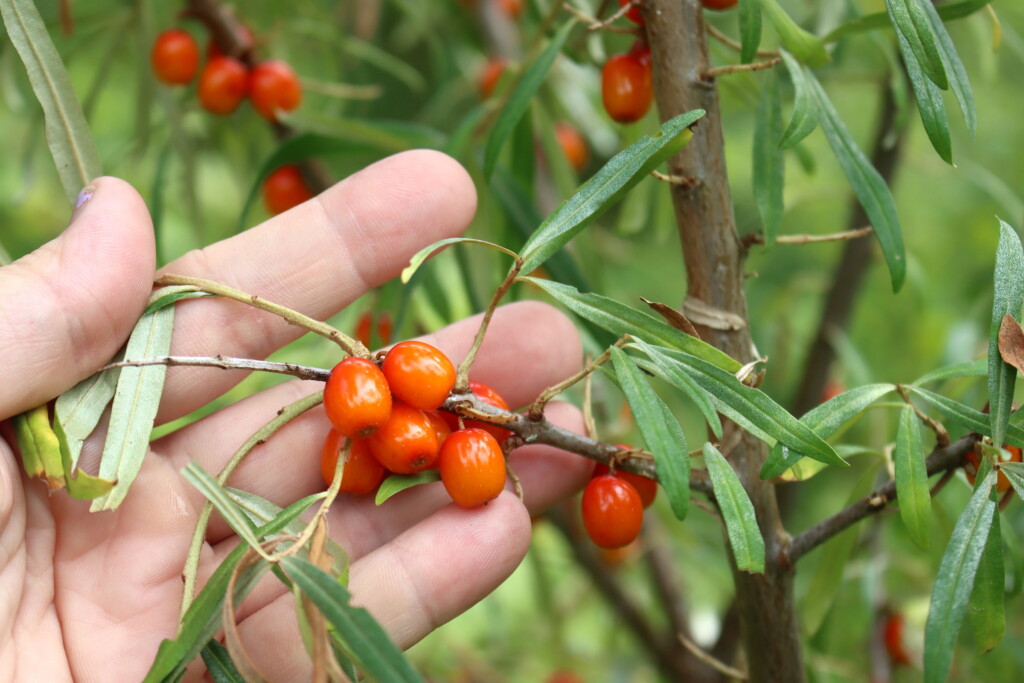
Why Make Wine from Seaberries?
Sea buckthorn (Hippophae rhamnoides) berries are often used in juice blends and herbal remedies, but they’re not commonly made into wine—and that’s a shame, because they ferment beautifully. Their naturally high acidity and complex flavor profile make them ideal for winemaking.
Seaberries are:
- Tart and flavorful – like a mix of citrus, pineapple, and passionfruit
- High in antioxidants – giving your wine rich color and excellent aging potential
- Packed with vitamin C – which can help stabilize the wine and lower spoilage risk during fermentation
This wine can be enjoyed young, but it’s best when aged for at least 6 months. It’s particularly good chilled on its own or mixed into sparkling wine for a tart, golden mimosa.
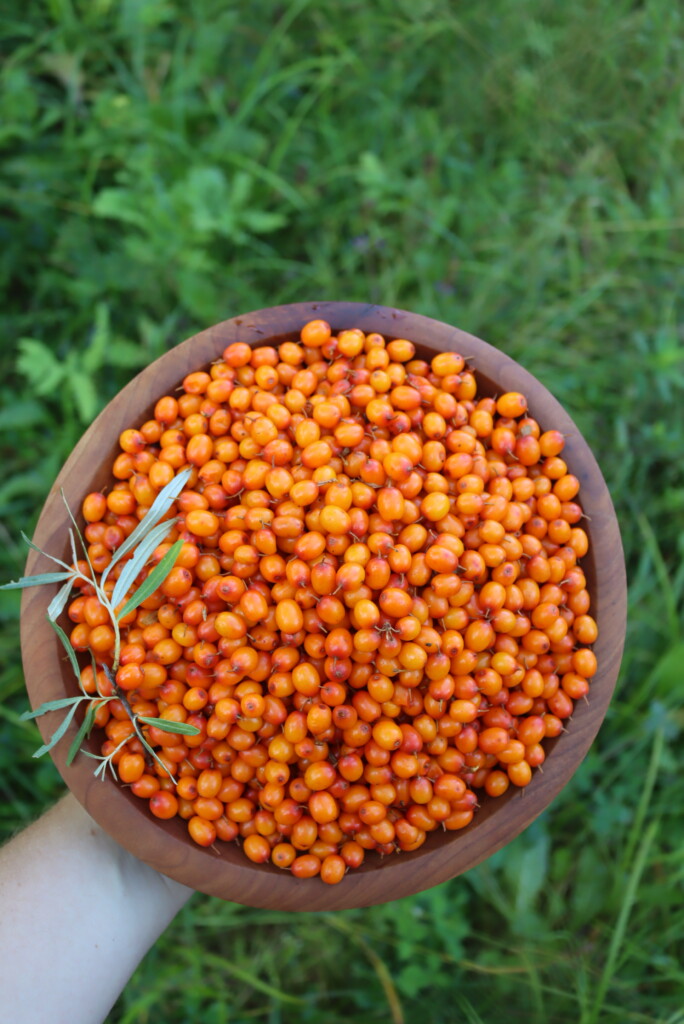
Ingredients for Seaberry Wine
To make a 1 gallon batch of seaberry wine, you’ll need:
- 3 lbs seaberries (fresh or frozen) – The fruit are juicy and acidic, so don’t add any additional acid to your wine. If you start with about 3 lbs of fruit, that’s about 2 quarts of fruit as harvested, and makes about 1 quart of juice through a food mill.
- 3 lbs sugar or honey – Sugar provides the fermentable fuel for the yeast, ultimately determining the wine’s alcohol content. Using white sugar results in a crisp, clean finish, while honey adds subtle floral complexity and rounds out the tartness of the berries.
- 1 tsp yeast nutrient – Seaberries are low in certain nutrients that wine yeast needs to thrive. This additive gives the yeast a balanced food source, helping to prevent stuck fermentations and off-flavors.
- ¼ tsp wine tannin – Tannin contributes a slight astringency and structure to the finished wine, improving mouthfeel and aging potential. Since seaberries are relatively low in natural tannin (especially if you strain out the skins and seeds), a small addition helps balance the wine.
- 1 packet wine yeast (Lalvin 71B, EC-1118 or QA23 recommended) – Wine yeast strains are selected for their flavor profiles and fermentation strength. Lalvin 71B enhances fruity, aromatic notes—great for seaberries—while EC-1118 is a strong, reliable fermenter that works well if you’re unsure of conditions. QA23 is a good all purpose wine and mead yeast.
- 1 Campden tablet (optional) – Crushed Campden tablets release sulfur dioxide, which kills off wild yeasts and bacteria in the must before you pitch the wine yeast. This step isn’t required, but it can help ensure a clean, controlled fermentation. I don’t use campden tablets.
- Water to make 1 gallon – Dilutes the must to the proper volume and balances the sugar concentration. Use filtered or dechlorinated water, as chlorine can inhibit yeast activity.
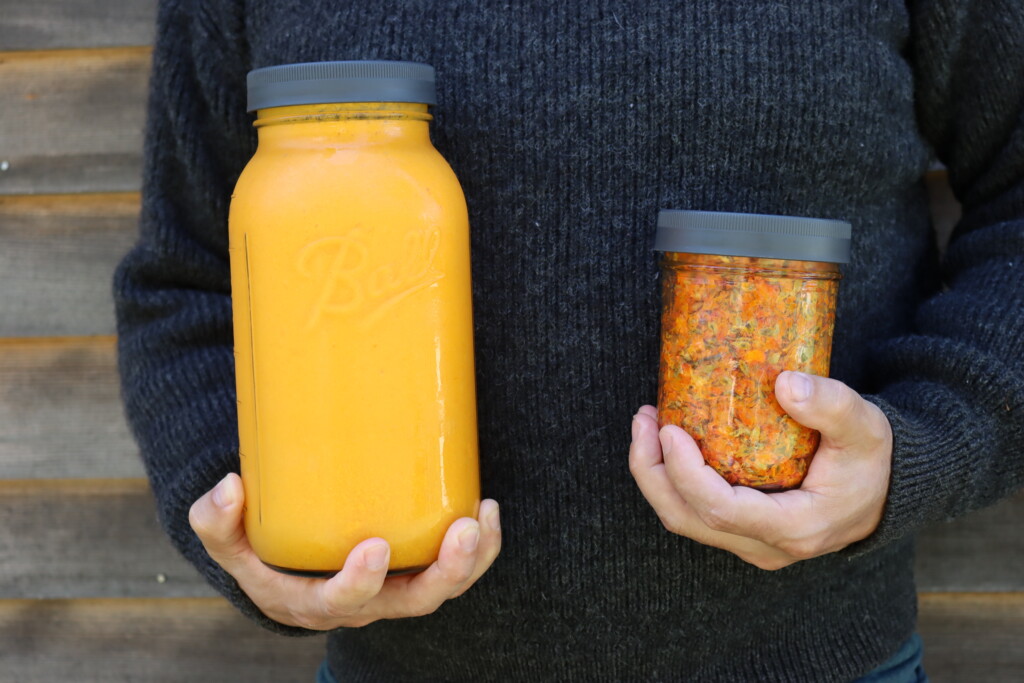
How to Make Seaberry Wine
Begin by preparing your fruit. Add the seaberries to a clean primary fermenter or fermentation bucket. Gently crush them with a sanitized spoon or potato masher to break the skins and release their juices. If you’d rather avoid seeds in your wine, you can run the berries through a food mill instead, which yields a smooth, seed-free pulp. Either method works well, but avoid heating the berries—seaberry wine tastes best when the fruit is kept raw.
Next, bring about half the total water (roughly ½ gallon) to a boil. Remove from heat and stir in all the sugar or honey until completely dissolved. Allow the mixture to cool to room temperature before pouring it over the seaberries in the fermenter. Add the rest of the water along with the wine tannin and yeast nutrient.
At this point, if you’re using a Campden tablet to sterilize the must, crush it and stir it in thoroughly. Cover the fermenter loosely and let it sit for 12 to 24 hours to allow the Campden to neutralize wild yeasts and bacteria. If you’re skipping the Campden tablet, simply wait until the mixture is fully cooled before moving on.
Once the must is at room temperature, sprinkle the wine yeast over the surface and stir gently to incorporate. Cover the fermenter with a lid or clean cloth, and attach an airlock if your setup allows. Let the mixture ferment in primary for 7 to 10 days, stirring once or twice daily to keep the fruit submerged and promote an even fermentation.
As fermentation begins to slow, it’s time to separate the liquid from the solids. Strain out the seaberries using a fine mesh strainer or cheesecloth, and transfer the liquid to a clean glass carboy or secondary fermenter. Top off with a bit of water if needed to fill the jug to the neck, then fit it with an airlock.
Secondary fermentation will take another 3 to 6 weeks. Once bubbling has completely stopped, rack the wine off the sediment into a clean container. You may need to repeat this process a couple of times over the next few months until the wine clears and stabilizes.
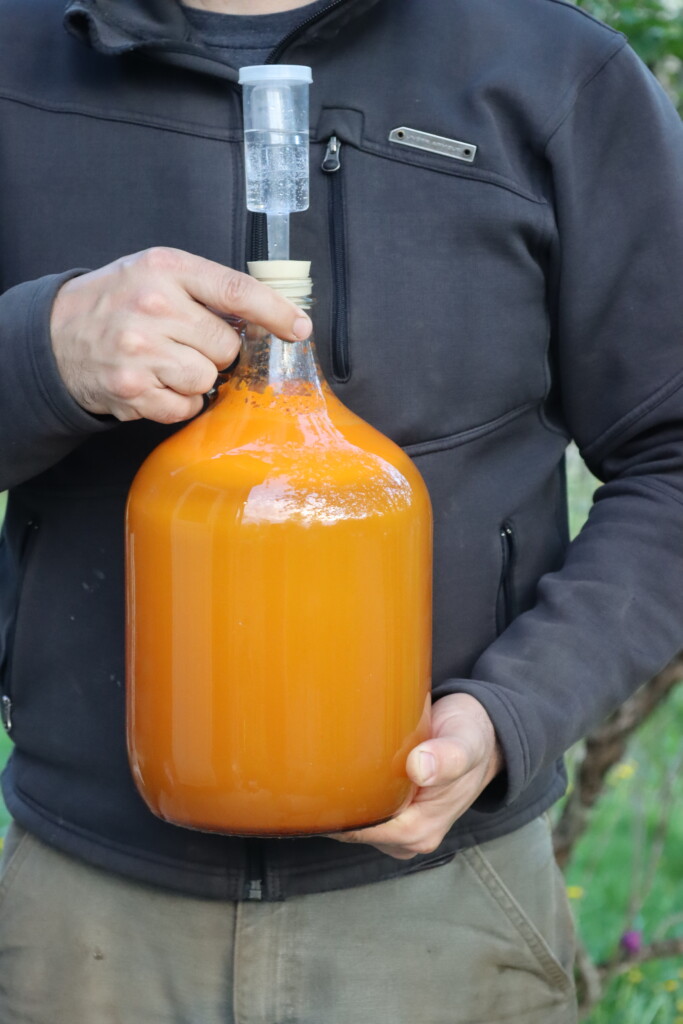
Once the wine is clear and stable, you can choose to back-sweeten if desired. Just prepare a simple syrup with sugar or honey and stir it in to taste. For best results, rack the wine again after sweetening and let it sit for a week or two to ensure fermentation doesn’t restart in the bottle.
When you’re satisfied with the flavor and clarity, bottle the wine in clean, sanitized wine bottles and cork or cap. Age in a cool, dark place for at least 6 months before drinking. Like most fruit wines, seaberry wine only improves with time—and you’ll find the tartness softens beautifully as it ages.
FAQ
Yes! Frozen seaberries work just as well and may be easier to juice after thawing. No need to defrost them fully before starting, just crush gently and proceed with the recipe.
This recipe typically produces wine around 11–13% ABV, depending on sugar content and yeast strain. Since seaberries are quite acidic, there’s a good bit of sugar in the recipe so that there will be extra residual sweetness once fermentation is complete.
Yes—while it’s drinkable young, aging at least 6 months helps mellow the tartness and improve overall balance.
It’s crisp, citrusy, and a little tropical—somewhere between passionfruit, orange, and grapefruit. A refreshing summer wine, especially when chilled.
Seaberry Recipes
Looking for more ways to use seaberries?
Homemade seaberry jelly is a quick and easy way to preserve a bumper crop of fruits. It’s great on toast or in thumbprint cookies.
For drinks or as a health tonic, seaberry oxymel is an old fashioned remedy made with sea buckthorn, honey and apple cider vinegar. It’s shelf stable after the fruit infuse, and easy to make at home.
And, of course, you can always extract and preserve seaberry juice if you want the most versatility.
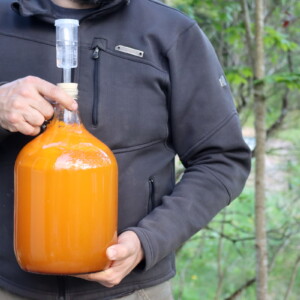
Seaberry Wine (Sea Buckthorn Wine)
Equipment
- Air Lock & Stopper
Ingredients
- 3 lbs seaberries, fresh or frozen, about 2 quarts whole fruit or 1 quart juice
- 3 lbs sugar, or honey
- 1 tsp yeast nutrient
- ¼ tsp wine tannin
- 1 packet wine yeast, Lalvin 71B, EC-1118 or QA23 recommended
- 1 Campden tablet, optional, to sterilize must
- Water to make 1 gallon
Instructions
- Start by placing the seaberries into a clean fermenting bucket or primary fermenter. Slightly crush them with a potato masher or sanitized spoon to release the juice—just enough to break them open. Or, if you have a food mill, run the berries through the food mill as I’ve done to extract a seed free juice. It tastes better if you leave them raw, so either use whole fruit or pulp from a food mill, but don’t use heat to extract the juice.
- Bring half the water (about ½ gallon) to a boil, then dissolve the sugar or honey into the hot water. Once fully dissolved, allow it to cool to room temperature, pour the sugar water over the berries in the fermenter. Add the remaining water, wine tannin, and yeast nutrient.
- If you’re using a Campden tablet, crush and stir it in at this point to sanitize the must. Cover loosely and allow to sit for 12 to 24 hours before pitching the yeast. If skipping Campden, you can add the yeast right away (but be sure everything is room temperature before adding the yeast).
- When ready, sprinkle the wine yeast on top of the must and stir gently to combine. Cover with a lid or clean cloth and fit with an airlock if using a fermenter bucket.
- Allow the mixture to ferment in primary for 7 to 10 days, stirring daily to keep the fruit submerged. After bubbling slows, strain out the seaberries and transfer the liquid to a clean carboy or jug for secondary fermentation. Top off with water if needed and attach an airlock.
- Let the wine ferment slowly for 3 to 6 weeks, or until bubbling stops completely. Once fermentation is complete, rack into a clean jug, leaving the sediment behind.
- Repeat racking every few months as needed until the wine clears. Bottle when clear and stable, then age at least 6 months for best flavor.
Notes
Nutrition
Nutrition information is automatically calculated, so should only be used as an approximation.
Winemaking Recipes
If you’re diving into homemade wine, I’ve got plenty of unique recipes to guide you beyond the basics. While you can always make wine from grapes, there are plenty of other creative fruit wine recipes worth trying.
For something rich and traditional, try Elderberry Wine or Blackcurrant Wine.
If you’re after more unusual ferments, Rosehip Wine and Hawthorn Wine are both packed with vitamin C and have a delicate, floral tang, while Husk Cherry Wine offers a surprisingly tropical flavor from these ground cherry relatives.
I also have a full tutorial on How to Make Country Wine, which walks you through the process step by step—perfect if you’re just getting started or looking to experiment with your garden or foraged harvest.
